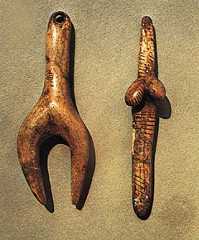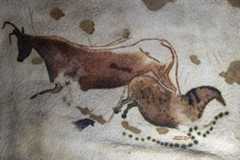Aurignacian culture
Our editors will review what you’ve submitted and determine whether to revise the article.
Aurignacian culture, toolmaking industry and artistic tradition of Upper Paleolithic Europe that followed theMousterian industry, was contemporary with the Perigordian, and was succeeded by the Solutrean. The Aurignacianculture was marked by a great diversification and specialization of tools, including the invention of theburin, or engraving tool, that made much of the art possible.
The Aurignacian differs from other Upper Paleolithic industries mainly in a preponderance of stoneflake tools rather than blades. Flakes were retouched to make nosed scrapers, carinate (ridged) scrapers, and end scrapers. Blades and burins were made by the punch technique and came in several sizes. Bones and antlers were made into points and awls by splitting, sawing, and smoothing; split-base and biconical points provide evidence for hafting.
The art of the Aurignacian culture represents the first complete tradition in thehistory of art, moving from awkward attempts to a well-developed, mature style. The earliest examples of the small, portable art objects produced during this period are from westernEurope and consist of pebbles with very simple engravings of animal forms. Later, animal figures were carved in pieces ofbone andivory. At the same time, a tradition of true sculpture in the round grew up in eastern Europe, with vividly realistic, though simple, clay figurines of animals and highly stylized statuettes of pregnant women, the so-called Venus figures, presumably fertility figures. In the later part of the Aurignacian Period, a fusion of Eastern sculptural and Western linear traditions occurred in the West, resulting in small carvings of greatly increased naturalism; the engraved details show attempts at foreshortening and shading with cross-hatched lines.
- Related Topics:
- Paleolithic Period

Cave art was produced almost exclusively in western Europe, where, by the end of the Aurignacian Period, hundreds of paintings, engravings, and reliefs had been executed on the walls, the ceilings, and sometimes the floors of limestone caves. Probably the first paintings are stencilings outlined in colour of actual hands held against thecave walls. The stencilings were succeeded by the development of figural painting. Acharacteristic feature of these early pictures, which persisted throughout the Aurignacian period, is their “twisted perspective,” which shows, for example, the head of the animal in profile and its horns twisted to a front view. One of the finest examples of Aurignacian art is represented by paintings of animals, such as horses and bulls, on the walls and ceilings of the cave atLascaux, in southwesternFrance. These impressive figures, painted in vivid polychrome red, yellow, brown, and black, with solid, closed outlines, show the lively naturalism, close observation of nature, and linear, one-dimensional approach that characterized mature Aurignacian art.










